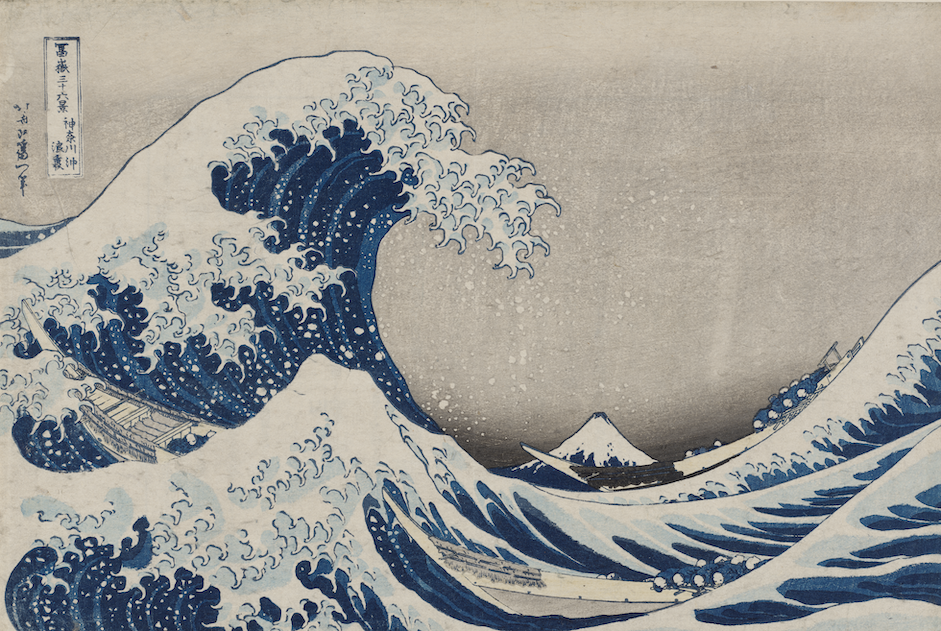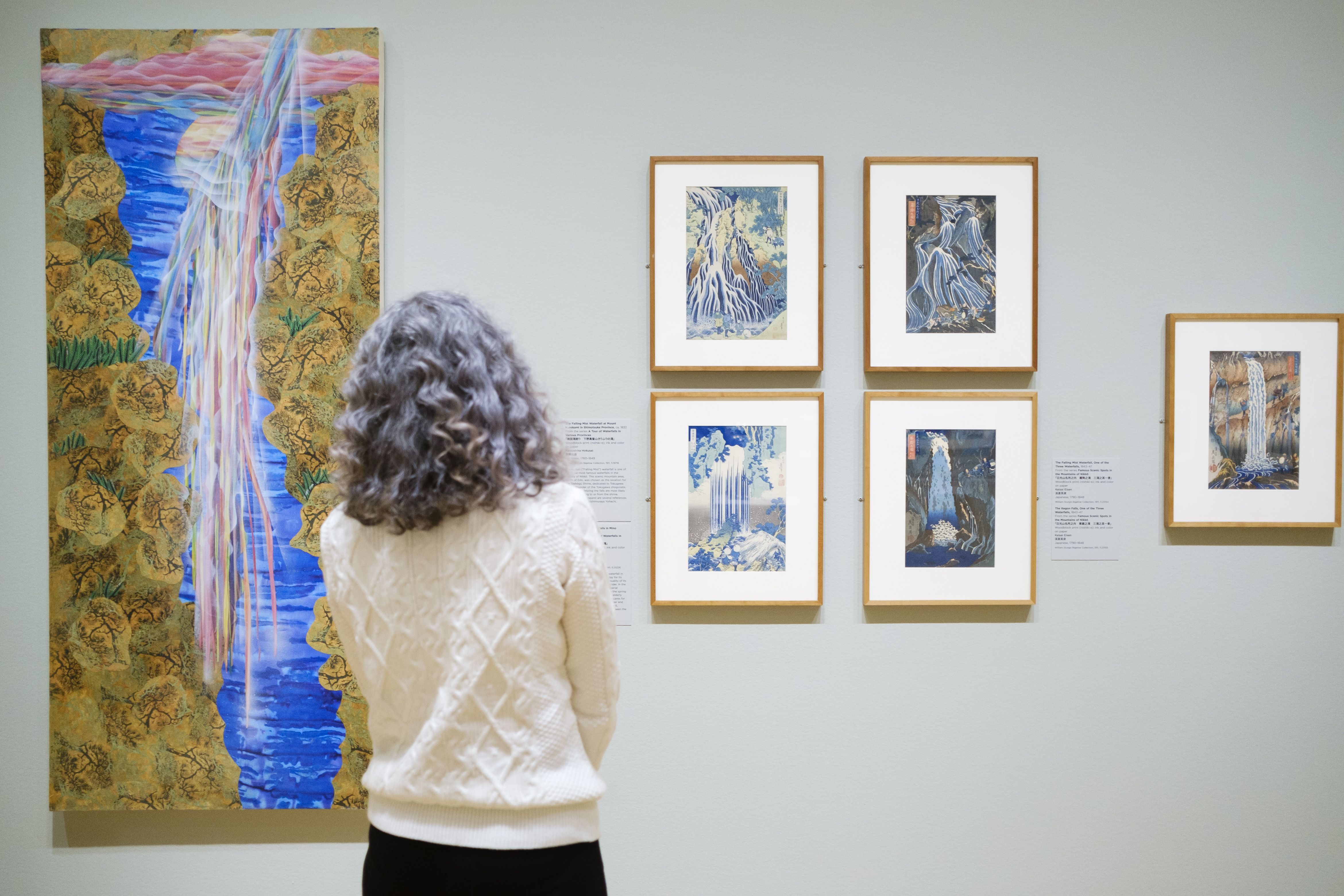Go Beyond the Great Wave: Hokusai, History, and the Art of Curation
Review of Hokusai: Inspiration and Influence at Seattle Art Museum
Written by TeenTix Newsroom Writer Kaylee Yu and edited by Teen Editorial Staff Members Anna Melomed and Kyle Grestel

Katsuhika Hokusai’s The Great Wave off Kanagawa (known more widely as The Great Wave) is an instantly recognizable icon of pop culture. Everyone knows the deep Prussian blue waves, crested with curling white seafoam, standing stark against a tan-tinted sky. In the nearly 200 years since the 1830-‘31 production of the piece, it has been studied, recreated, and studied again, with The Wall Street Journal even calling it “possibly the most reproduced image in the history of all art.”
But there is infinitely more to Hokusai’s legacy than this 10-by-15-inch woodblock print.

The Seattle Art Museum’s exhibit Hokusai: Inspiration and Influence attempts to capture the magnitude of Hokusai’s achievements, finding his sumi-inked fingerprints in art culture hundreds of years after his death. The exhibit shows a broad swath of history, displaying not only over 100 works by the master, but also more than 200 pieces by his predecessors, students, rivals, and even his daughters. In addition, it contains many works by contemporary artists, drawing inspiration from or directly reinterpreting Hokusai’s prints. The SAM has told a story that spans both distance and time, showing how art inspires and informs us all.
Stepping into the exhibit, you first come face-to-face with three framed prints. Viewed from left to right (in traditional Japanese fashion), the prints that open the show are each by a different artist. First, you see Hokusai’s 1830 red Fuji, South Wind, Clear Sky; secondly, a reworking by one of his students; and lastly, the artwork White Fujiyama Ski Gelände, 1999, by artist Yoshimoto Nara. This sequence of prints, from antique to contemporary, prepares the viewer for a deep study of one of the greatest masters in art history.

Beyond this wall, the exhibit is organized thematically, with sections dedicated to countless aspects of Hokusai’s life and artwork. From a room focusing on Hokusai’s teachers and students to galleries each showcasing his private commissions, landscapes, nature studies, and folklore depictions, the show offers a comprehensive take on Hokusai’s legacy. Along with these rooms lined with perfect scrolls and prints, the SAM reveals Hokusai’s sketches—both his unfinished works and his sketchbooks themselves—giving the viewer a rare peek into the venerated master’s process.
Hokusai’s woodblock prints are known by art historians as Ukiyo-e (浮世絵), a Japanese genre of printmaking that translates as “pictures of the floating world.” The term ukiyo (floating world) was synonymous with a hedonistic lifestyle in the Edo period. As a result, the subjects of many of these Ukiyo-e prints are entertainers such as kabuki actors, sumo wrestlers, geisha, and prostitutes. Hokusai didn’t shun “eye-candy” subjects—many of his pieces are of entertainers, not to mention his works of erotica—but he also popularized landscapes as a subject of Ukiyo-e, a revolution he is lauded for to this day.
In contrast to the silk scrolls and folding screens, the SAM’s exhibit also features works of modern art. In rooms closer to the back of the show (following the narrative of Hokusai’s influence), contemporary pieces abound. The diversity in the display is incredible. Manga pages hang on the walls alongside impressionist oil paintings, and vibrant mixed-media sculptures pose on pedestals with delicate ceramics. Photographic statements on femininity face off with inky prints of lobsters—the list goes on and on. However, the name of Hokusai tying the collection of contemporary art together wasn’t enough to give these works a cohesive theme or direction.
Oftentimes, I felt directionless exploring this exhibit. Even with the well-told, concrete narrative, I sometimes found myself struggling to find relevance in the contemporary pieces displayed. After having seen so much story in the earlier parts of the exhibit, I couldn’t help but wonder why the more contemporary sections often felt disconnected.
That “directionlessness” could also be attributed to the layout of the show. It has a general, front-to-back traffic pattern, but I found the loopy hallway encasing the smaller galleries a vague indication of where the exhibit intended to lead. With the large crowds, a popular exhibition draws, as well as the meticulously planned nature of every other aspect of the show, I found this strangely up-in-the-air. Making my way through the swirling, eddying mass of people felt much like the boats in The Great Wave must have, tossed around and confused.
Despite my difficulty navigating the show, there is no denying that Hokusai: Inspiration and Influence is an exhibit handled with exceeding care and attention to detail. The historical works tell a compelling and fascinating narrative, and the modern art section, though somewhat removed from the rest of the exhibit, is enjoyable and intriguing. Curating an exhibition as thorough as this one is no small matter, and the team of curators who crafted Hokusai have not only shown the artwork of one of Japan’s foremost geniuses, but have, in doing so, put forth a retrospective so scholarly, and exhaustive that it is–flaws and all–a work of art.
Lead Photo Credit: Copyright: Photo: L.Fried, "Hokusai: Inspiration and Influence" press preview, 10.17.23
The TeenTix Newsroom is a group of teen writers led by the Teen Editorial Staff. For each review, Newsroom writers work individually with a teen editor to polish their writing for publication. The Teen Editorial Staff is made up of 5 teens who curate the review portion of the TeenTix blog. More information about the Teen Editorial Staff can be found HERE.
The TeenTix Press Corps promotes critical thinking, communication, and information literacy through criticism and journalism practice for teens. For more information about the Press Corps program see HERE.

